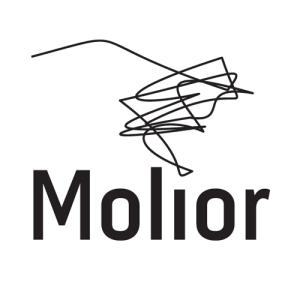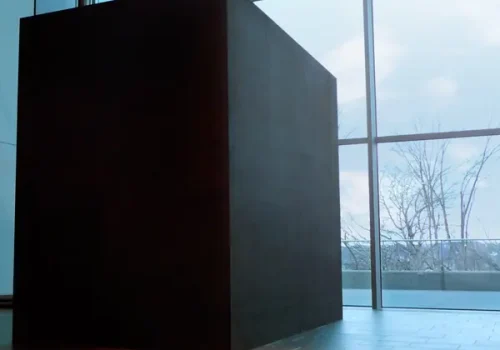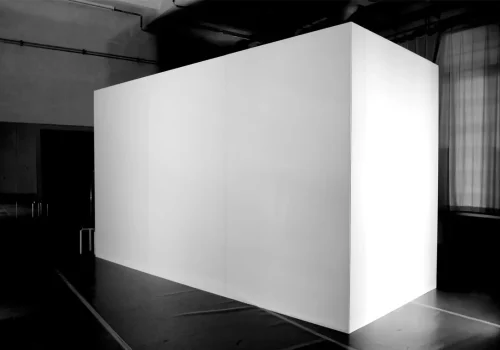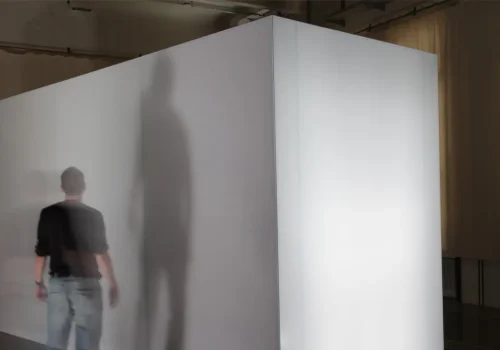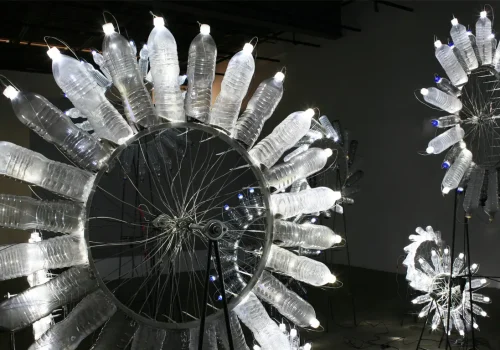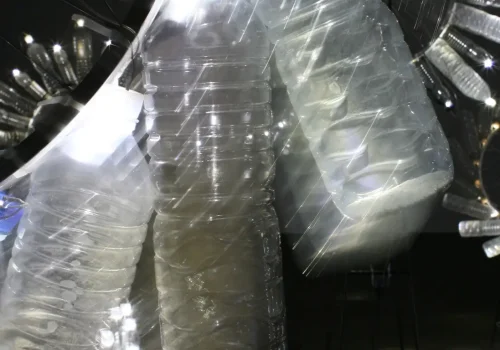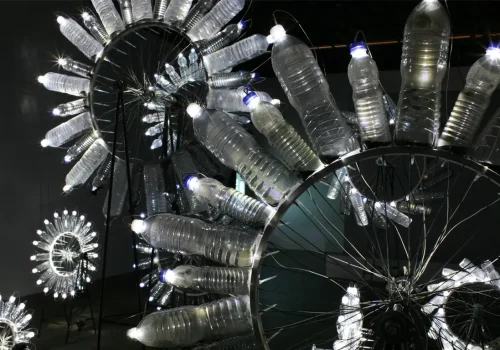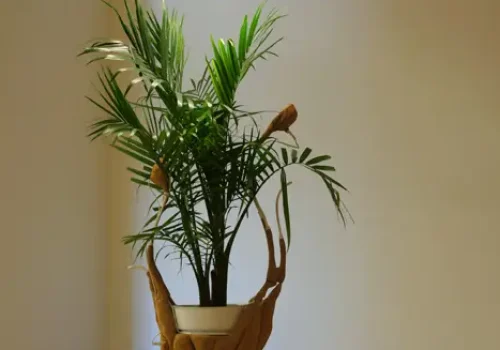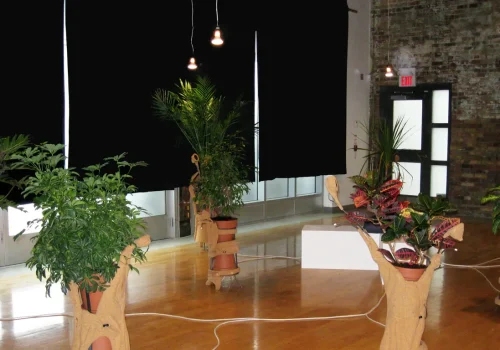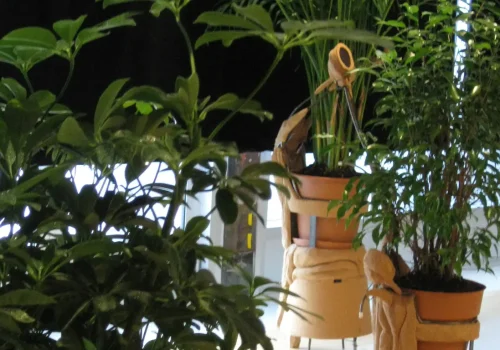TransLife International Triennial of New Media Art
National Art Museum of China, Beijing
From July 26th to August 17th, 2011
Following the groundbreaking international new media art exhibition Synthetic Times, a 2008 Beijing Olympics Cultural Project, the National Art Museum of China presents TransLife, the next installment of the Media Art China series, now instituted as a triennial, slated to open on July 26, 2011, in Beijing.
Amidst the global challenges of climate and ecological crises that threaten the very existence of humanity, the exhibition TransLife reflects on the whereabouts of humankind in relationship to nature through an unique perspective and philosophical speculation, calling for citizen participation in facing these imminent challenges with artistic imagination to advocate a new world view of nature and a retooled humanist proposition.
The exhibition is structured by three thematically related components that gradually progress from the discovery of new sensorial potentials that extend our cognitive capacities to the emergence of multiple life forms to biodiversity and an exploration of the symbiosis of cohabitation, revealing emerging concepts of life and provoking contemplation on the biosphere. In doing so, the exhibition also strives to reassess the historical roots and epistemological foundation of the current ecological and environmental predicament, interrogating the notion of subjectivity inherent in the project of modernity and the anthropocentrism derived from that tradition.
The exhibition’s architectural design starting with the first floor of the museum and extending to the third and the uppermost floors resonates with exhibition’s thematic construct in which the progression from the sensorial experiences of the individual to the recognition of the multitude of life phenomena and, finally, to the attention to life-sustaining ecosystems echoes with the emotional and perceptual evolution from micro-worlds to a macro-universe, making the curatorial concept an organic and symbolic physical presence.
TransLife will bring to the Beijing audience an unparalleled roster of 53 artworks by over 80 artists and artist collectives from China, Korea, Japan, Singapore, the United States, Canada, Mexico, Brazil, Spain, Italy, France, Germany, Switzerland, Austria, The Netherlands, Latvia, Ireland, UK, Finland, Belgium, Norway, Serbia and Australia. 40 works will be included in the theme exhibitions and 13 works will be installed in the “Weather Tunnel” special project.
The exhibition will occupy three galleries on the museum’s first floor and the entire space of the museum’s 3rd and 5th floors, totalizing over 4000 square meters.
The cutting-edge Chinese architect MA Yansong will design a large installation for “Weather Tunnel” in collaboration with emerging artists from a selection of leading art schools in an open area of the museum.
The 300 page plus exhibition catalogue will consist of a collection of scholarly texts contributed by world-renowned authors (Bruno Latour, Arjen Mulder, Chris Salter, Peter Sloterdijk, Eugene Thacker, and a curatorial text by ZHANG Ga) to elaborate on the exhibition’s themes and their philosophical ramifications, along with color illustrations of works in the exhibition. The catalogue will be co-published by NAMOC, The Liverpool University Press and the Foundation for Art and Creative Technologies in UK and distributed globally.
Artistic Director / Curator, ZHANG Ga
Zhang Ga
Zhang Ga is a media art curator, professor of Media Art at Academy of Arts and Design, Tsinghua University (Beijing), and associate professor of Media Design at the School of Art, Media and Technology at Parsons The New School for Design (New York). He also holds appointments as Consulting Curator of Media Art at the National Art Museum of China, Senior Researcher at the Media x Design Lab of EPFL | Swiss Federal Institute of Technology Lausanne and Visiting Scientist at the MIT Media Lab in the U.S. He was Artistic Director / Curator of Synthetic Times: International New Media Art Exhibition, a Beijing Olympics Cultural Project organized by the National Art Museum of China in 2008 (catalogue by the MIT Press), among numerous other curatorial projects. He has been on many jury and consultation committees including the (former) World Trade Center Artist Residency Program, Rockefeller New Media Fellowship National Nomination Committee, Prix Ars Electronica among others. He organized and curated the First, Second and Third Beijing International New Media Art Exhibitions and Symposiums, extending the global new media art discourse into mainland China. He has lectured widely around the world; most recently he was a keynote speaker at Re:Live09, Third International Conference on the Histories of Media Art, Science and Technology. In 2010, he founded China’s first media art lab at Tianghua University.
Artists & works
Chris Salter – Marije Baalman – Harry Smoak
JND (just noticeable difference)
2009-2010
Installation
Description of the work
JND is a sensory environment for one person at a time lying in total darkness. The installation is based on Gustav Fechner’s concept of the Just Noticeable Difference: the ability to perceptually detect the smallest changes in sensory stimuli. Combining near darkness with extraordinary low levels of vibration, light and sound, visitors enter the pitch dark black box and lie down on a raised, body length surface. Once inside, visitors experience a “composition of touch, light and sound”; an extraordinarily wide range of visual, auditory and tactile sensations that challenge how we perceive the smallest degrees of change in sensory stimuli over different levels of intensities.
Biography
Chris Salter is an artist, Assistant Professor for Computation Arts at Concordia University and researcher at the Hexagram Institute in Montréal. He collaborated with Peter Sellars and William Forsythe and co-founded the collective Sponge. Salter’s performances, installations, research and publications have been presented at numerous festivals and conferences around the world, including the Venice Architecture Biennale, Ars Electronica, Exit Festival-MAC Creteil, V2-Rotterdam, Place des Arts, Elektra Festival-Montréal, Dance Theater Workshop, Shanghai Dance Festival, Transmediale, Attakkalari India Biennial and many others. He is the author of the book Entangled: Technology and the Transformation of Performance (MIT Press, 2010).
Marije Baalman studied Applied Physics at the Technical University in Delft (1996-2002) and Sonology at the Royal Conservatory in The Hague (2001-2), and did a Ph.D. at the Technical University of Berlin on spatial sound and
electronic music (2002-7). She was a post-doctoral researcher in Computation Arts at Concordia University in Montreal (2007-10). In her artistic work she is interested in the realtime components of the work: nothing is precomposed, but rather the (mostly) sonic output depends on realtime interactions, either of the performer, or the audience. Thus composition becomes more the composing of behaviours and interaction modalities, creating processes, rather than fixed sound tracks. This is expressed with tools such as physical computing, livecoding, digital and analog sound processing, and improvisation.She has collaborated with various people, amongst which Alberto de Campo, Chris Salter, Harry Smoak, Michael Schumacher, Attakkalari Dance Company and Workspace Unlimited.
Harry Smoak is a PhD candidate in the SIP program at Concordia University and senior research associate at the Hexagram Institute in Montréal (Québec). His current artistic and research interests revolve around the design of real-time responsive media environments. Often working together with Chris Salter and Marije Baalman, his collaborative and solo work has been presented internationally at a number of festivals and conferences. He is an adjunct professor and guest lecturer in the Department of Design and Computation Arts at Concordia where he teaches in areas of real-time media, immersive environments, and critical studies of media arts and sciences. Harry is a graduate of the Georgia Institute of Technology having received his Masters in Human-Computer Interaction.
Diane Landry
Knight of Infinite resignation
2009
Sound installation with automation
Description of the work
This intricate web of turning lights and darks operates cyclically, as does the iron installation. Lights appear and disappear with the rotation of the wheels, and the number of the wheels-twelve-references both the hours of the clock and the months of the year. Sand pours down the bottles as though they were hourglasses. But if the windmills suggest human patterns of time, they also allude to perpetual motion machines and thus a different scale of measurement if not a state beyond temporality. Although actually run by electricity, the form of the assemblages, with the running sand acting as weights, evokes the overbalanced perpetual motion wheels (dating to the middle ages, by Bhaskara, Villard de Honnecourt, and others) that were designed, futilely, to rely on inertia to spin forever. On earth perpetual motion seems to be an impossible fantasy, though in space planets and stars spin for unfathomable spans of time without energy input. The tension between human time and eternity is thus condensed into these enigmatic wheels, as is that between human and cosmic scales: the viewer oscillates between recognizing the hand-held water bottle and seeing star systems in their arrangement.
In a number of earlier works, Landry has called attention to the threat to our most precious resource: clean water, which is conspicuously absent from the bottles here. Filled with sand, the bottles are dried up, sterile. In Quebec water is intimately linked to the question of energy, and thus the perpetual motion problem and fantasy. There are 237 bottles here, the liquid contents of which would apparently fill a bath-no more. The short-sightedness of human management of natural resources is made pitifully obvious by the work’s evocation of cosmic time, in comparison with which the human lifespan and even the existence of the species seem simply irrelevant. And there is something terrifying about this assemblage, which is so cold and serene, so unperturbed by the viewer’s presence.
(Excerpt from DVD catalogue « Diane Landry, installations & performances 2008-2009 », text by Alison Syme, L’Œil de Poisson, 2010, p.4-5.)
Biography
Diane Landry lives and works in Québec City. Since 1987, her works have travelled widely across Canada and in major cities in the USA, Mexico, Argentina, many European countries, Australia and China. Her works have been discussed in numerous publications and recognized by important awards in Québec as well as in the United States. She is the first recipient of the prestigious Giverny Capital Prize, a distinction awarded to a visual artist from Québec. She has been an artist in residence in many centres in Canada, the USA, France, Italy and Argentina. She has just completed a six-month stay in the Studio du Québec in New York, sponsored by the Conseil des arts et des lettres du Québec. Diane Landry holds a MA from Stanford University, California. The artist is represented by SolwayJones Gallery in Los Angeles.
Jane Tingley
Plant(ipod)
2008
Installation
Cork, steel, electronics, sensors, Max/MSP
Description of the work
L’installation Plantes (iPod) explore la relation active entre les objets occupant l’espace de la galerie et le corps du spectateur. De nature avant tout sculpturale, l’installation comprend huit plantes et objets prothétiques de différentes formes et tailles placés ici et là dans la galerie. D’aspect organique, les objets contiennent des plantes d’intérieur encastrées dont les formes font référence à des arbres. Chaque objet sculptural comprend un caisson de graves encastré d’où s’élèvent des branches métalliques qui maintiennent deux petits haut-parleurs près de la partie feuillue de la plante, le tout fonctionnant comme une chaîne audio. Chaque objet contient des capteurs et des haut-parleurs, de sorte que les sons émis vers les plantes sont directement influencés par l’emplacement et la distance relative du spectateur. Lorsque l’installation est au repos, les plantes iPod font jouer des sons de respirations humaines. Au gré des déplacements du spectateur, les sons émanant des plantes les plus proches vont et viennent en se mêlant à des récitatifs en plusieurs langues. Chaque son est plutôt faible et le spectateur doit s’approcher pour écouter les narrations, ce qui réduit la distance entre les plantes et lui.
Cette œuvre constitue une exploration de la poétique présente dans la création de nouvelles relations entre la vie humaine et la vie végétale, et remet en question la pensée hiérarchique traditionnelle qui place la seconde au-dessous de la première. Cette installation évoque la possible émergence de technologies naturocentriques plutôt qu’anthropocentriques, et redonne son souffle vital au concept de forêt enchantée.
Biography
Jane Tingley, who received her MFA from Concordia University in 2006, uses new media, sculpture, and installation to explore ideas involving identity and contemporary experience. She is one of the founding members of the Modern Nomads and has participated in exhibitions and festivals in Canada, Asia, and Europe, including Translife – International Triennial of Media Art at the National Art museum of China in Beijing, the Canadian Embassy and Gallerie Le Deco in Tokyo, Japan, Festival Break 2.3 in Ljubljana, Slovenia, Elektra Festival in Montreal, and the Künstlerhaus in Vienna, Austria. She was awarded the Kenneth Finkelstein Prize in sculpture, and has received support from a number of funding agencies, including the Manitoba Arts Council, Conseil des arts et des lettres du Québec, and the Canada Council for the Arts.
